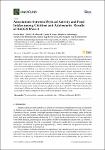Associations between Physical Activity and Food Intake among Children and Adolescents: Results of KiGGS Wave 2
Manz, Kristin
Mensink, Gert B. M.
Finger, Jonas D.
Haftenberger, Marjolein
Brettschneider, Anna-Kristin
Lage Barbosa, Clarissa
Krug, Susanne
Schienkiewitz, Anja
A balanced diet and sufficient physical activity are essential for the healthy growth of children and adolescents and for obesity prevention. Data from the second wave of the population-based German Health Interview and Examination Survey for Children and Adolescents (KiGGS Wave 2; 2014–2017) were used to analyse the association between food intake and physical activity among 6- to 17-year-old children and adolescents (n = 9842). Physical exercise (PE) and recommended daily physical activity (RDPA) were assessed with self-administered questionnaires and food intake by a semi-quantitative food frequency questionnaire. Multivariable logistic regression was used to analyse the association between food group intake (dependent variable) and level of PE or RDPA. High levels of physical activity (PE or RDPA) were associated with higher consumption of juice, water, milk, dairy products, fruits, and vegetables among both boys and girls, and among boys with a higher intake of bread, potatoes/pasta/rice, meat, and cereals. Higher PE levels were also less likely to be associated with a high soft drink intake. High levels of RDPA were associated with high intake of energy-dense foods among boys, which was not observed for PE. This study indicates that school-aged children and adolescents with higher levels of physical activity consume more beneficial foods and beverages compared to those with lower physical activity levels.
Dateien zu dieser Publikation

